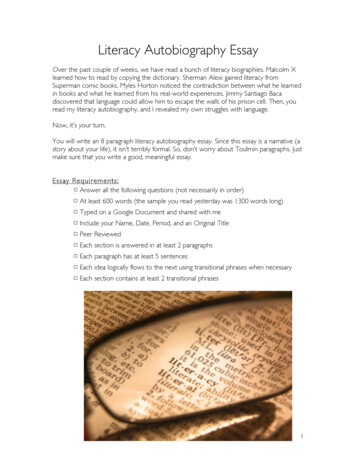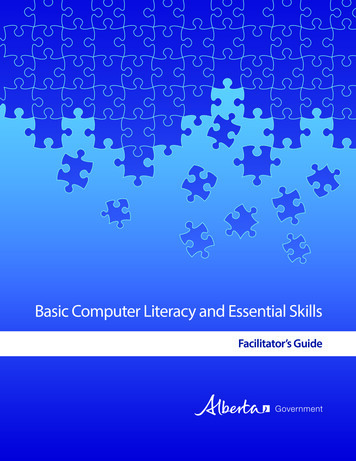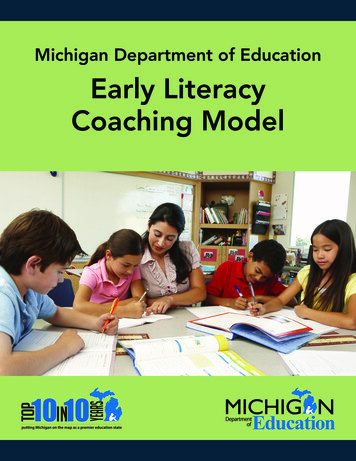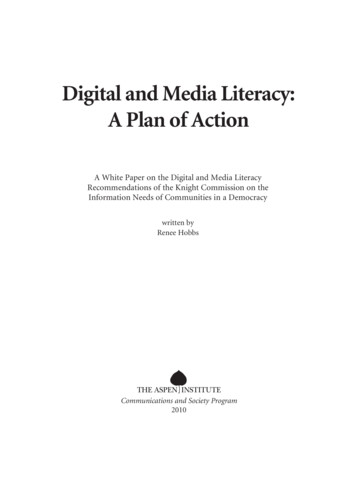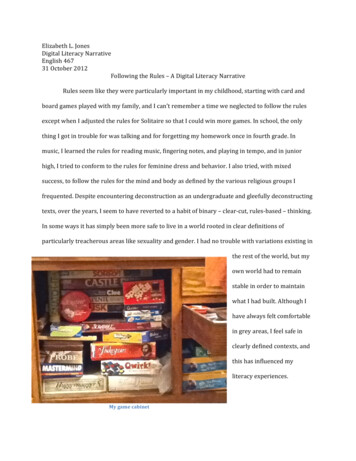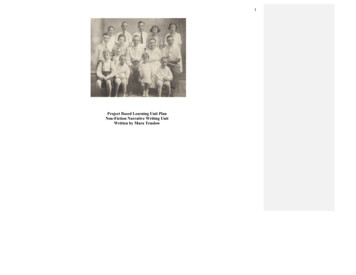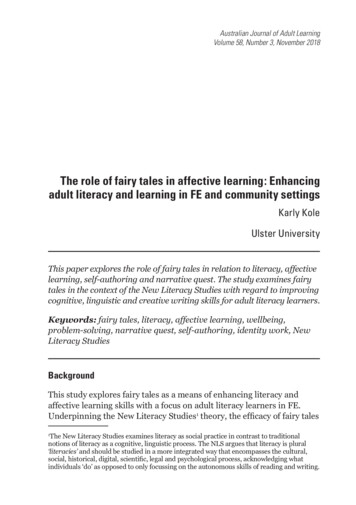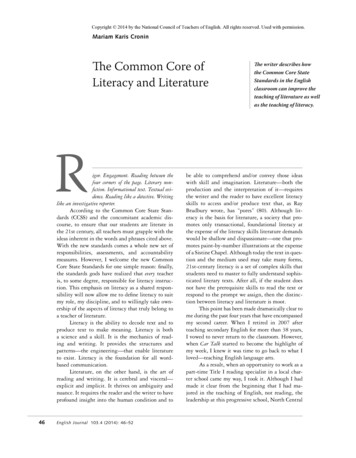
Transcription
Copyright 2014 by the National Council of Teachers of English. All rights reserved. Used with permission.Mariam Karis CroninThe Common Core ofLiteracy and LiteratureRigor. Engagement. Reading between thefour corners of the page. Literary non fiction. Informational text. Textual evi dence. Reading like a detective. Writinglike an investigative reporter.According to the Common Core State Standards (CCSS) and the concomitant academic discourse, to ensure that our students are literate inthe 21st century, all teachers must grapple with theideas inherent in the words and phrases cited above.With the new standards comes a whole new set ofresponsibilities, assessments, and accountabilitymeasures. However, I welcome the new CommonCore State Standards for one simple reason: finally,the standards gods have realized that every teacheris, to some degree, responsible for literacy instruction. This emphasis on literacy as a shared responsibility will now allow me to define literacy to suitmy role, my discipline, and to willingly take ownership of the aspects of literacy that truly belong toa teacher of literature.Literacy is the ability to decode text and toproduce text to make meaning. Literacy is botha science and a skill. It is the mechanics of reading and writing. It provides the structures andpatterns— the engineering— that enable literatureto exist. Literacy is the foundation for all word- based communication.Literature, on the other hand, is the art ofreading and writing. It is cerebral and visceral— explicit and implicit. It thrives on ambiguity andnuance. It requires the reader and the writer to haveprofound insight into the human condition and to46The writer describes howthe Common Core StateStandards in the En glishclassroom can improve theteaching of literature as wellas the teaching of literacy.be able to comprehend and/or convey those ideaswith skill and imagination. Literature— both theproduction and the interpretation of it— requiresthe writer and the reader to have excellent literacyskills to access and/or produce text that, as RayBradbury wrote, has “pores” (80). Although literacy is the basis for literature, a society that promotes only transactional, foundational literacy atthe expense of the literacy skills literature demandswould be shallow and dispassionate— one that promotes paint- by- number illustrations at the expenseof a Sistine Chapel. Although today the text in question and the medium used may take many forms,21st- century literacy is a set of complex skills thatstudents need to master to fully understand sophisticated literary texts. After all, if the student doesnot have the prerequisite skills to read the text orrespond to the prompt we assign, then the distinction between literacy and literature is moot.This point has been made dramatically clear tome during the past four years that have encompassedmy second career. When I retired in 2007 afterteaching secondary En glish for more than 38 years,I vowed to never return to the classroom. However,when Car Talk started to become the highlight ofmy week, I knew it was time to go back to what Iloved— teaching En glish language arts.As a result, when an opportunity to work as apart- time Title I reading specialist in a local charter school came my way, I took it. Although I hadmade it clear from the beginning that I had majored in the teaching of En glish, not reading, theleadership at this progressive school, North CentralEn g lish Journal 103.4 (2014): 46– 5 2EJ Mar2014 B.indd 462/21/14 3:48 PM
Mariam Karis CroninCharter Essential School, decided to take a chanceon me. Therefore, for the past three years, I havebeen immersed in issues related to literacy instruction. This year, however, I am back where I startedmy career— teaching several sections of ninth- gradeAmerican literature. Now, however, my teachinghas a new twist. I am attempting to rememberwhat I always knew. I am not teaching literature.First, my job is to teach students to understand literature. Second, my task is to teach them how toaccess, comprehend, and create literature by establishing a benchmark for their reading and writingskills and then ensuring that those skills expand.Indeed, my experience working as a Title Ireading specialist now informs my teaching in several specific ways worth sharing.teaching remedial reading, I now understand howvaried and complex reading problems can be. It isentirely possible, for example, that a student candecode words accurately, but because he or she hasnot achieved automaticity and fluency, the 30 pagesthat I estimated would take most students 30 to40 minutes to read might take that student threehours. No matter how well intentioned he or sheis, to this student my reading assignments soon become daunting.As a teacher of literature, I now see my recalcitrant students in a different light. Perhaps thosestudents who are acting out or procrastinating witha reading or writing assignment are doing so notbecause they want to engage me in a power struggle; perhaps they are just trying to tell me that theycan’t do what I’ve asked.What Teachers of Literature Needto Learn from Teachers of LiteracyStruggling readers can be helped, but onlyif given additional time on learning.It is easier for a student to refuse to read thanto admit he or she can’t.Contrary to what I had been led to believe earlier inmy career, even older students can be helped to improve their literacy skills. Admittedly, the job is farmore difficult the older a student is, but studentscan be helped at any age with appropriate, strategicinterventions.Our school has done an excellent job of helping secondary teachers, especially teachers of En glish, understand and interpret the data generatedby a number of literacy assessments. In the springof every school year, grade level teams gather withliteracy specialists to interpret the pre- and post- reading tests, as well as other qualitative assessmenttools. One literacy specialist at our school, PeteNelson, has shown us how to use the DiagnosticDecision Tree developed by Joseph K. Torgesen andLynda Hayes (see Figure 1). This protocol allows usto target the specific needs of students who scoredbelow average on norm- referenced reading assessments. We also consider the results of the most recent statewide (Massachusetts) assessment (MCAS)and our own in- house benchmarks, which are givenperiodically throughout the year in preparation forthe state assessment.In addition, under the guidance of Pete Nelson, we have used a protocol based on the workdone by the Kennewick, Washington, School District (Fielding, Kerr, and Rosier 38– 39) to help usdetermine how much additional time in literacyIn spite of the advent of high- stakes tests, I stillhave students who do not read on grade level. Reports such as Time to Act, commissioned by theCarnegie Council on Advancing Adolescent Literacy, suggest that my experience is not unique:the pace of literacy improvement in our schoolshas not kept pace with the accelerating demandsof the global knowledge economy. In state afterstate, the testing data mandated by No Child LeftBehind reveals a marked decline in the readingand writing skills of adolescent learners. (12)In my first career, however, I naively thoughtthat the students who didn’t read and/or write theassignments I gave were just bored or oppositional.Occasionally, I would find a text or a writing assignment that truly engaged these students, but,for the most part, I was too willing to accept thecommonly held assumption of that time— that afew of my students were just not programmed tolike reading and writing. Now I know better.Furthermore, as much as I have deplored thenarrowing of the curriculum and the punitive accountability measures that an over- emphasis onquantitative data has engendered, I have to admitthat when used wisely, data can and should informinstruction. Because of the work I have done inEnglish JournalEJ Mar2014 B.indd 47472/21/14 3:48 PM
The Common Core of Literacy and LiteratureFIGURE 1. Diagnostic Decision Tree for Students Performing Below Standards on a Measure of ReadingComprehension in Third Grade or LaterTOWRE Sight Word Efficiency(45 second subtest)Scores above 39%ileScores at or below 39%ile(for the student’s current grade level)(for the student’s current grade level)Stanford Diagnostic Reading TestTOWRE Phonemic Decoding(vocabulary & comprehension subtests)(45 second subtest)39%ile39%ileabove 39%ileat or below 39%ileQRI - 3Build FluencyCTOPP(Identify independent/(Elision subtest)instructional reading levels;diagnose reading/thinking strategies)above 39%ileat or below 39%ileIntensive phonicsNeeds phonics thatinstructionbuilds phonemicBackground knowledge?Vocabulary?Details/explicit questions?Inferring/implicit questions?awarenessSynthesizing/main idea?Test taking strategies.More higher order questioning.More practice writing extended responses citing support from the text.instruction our students need to “catch up” to theirgrade level (see Figure 2). As Lucy Calkins stateswhen she cites Malcolm Gladwell’s research intohow successful athletes and musicians gained theirexpertise: “The unifying factor that led to theirgreatness? Hours of practice. Hours and hours.Ten thousand hours. Readers, too, become greatwhen they have many hours of practice” (Calkins,Ehrenworth, and Lehman 31). Although North48Central Charter is not yet providing students withhours and hours of literacy practice, our emphasison literacy is having some impact. Arguably, thisemphasis is at least partially responsible for thefact that within Massachusetts’ state accountability classification system, NCCES moved up from aLevel Three designation (i.e., the lowest performing20 percent of schools) in 2011 to a Level One designation (i.e., a school meeting gap- narrowing goalsMarch 2014EJ Mar2014 B.indd 482/21/14 3:48 PM
Mariam Karis CroninFIGURE 2. Formula for Determining Catch- up Time Identify students whose GRADE (or similar normreferenced reading test) is below 50. Subtract the student’s percentile ranking from 50. Divide by 13 (13 percentile points one year ofgrowth) to approximate how many years behindgrade level the student is. Multiply the number of years behind grade level by50, which represents in minutes the unit of literacyneeded for a typical student to achieve annualgrowth.Based on these calculations, a student’s schedule wouldbe adjusted so that he or she would have the additionalminutes of literacy instruction per day beyond the grade- level ELA course to ensure annual growth as well ascatch- up growth.for all students, as well as for high- needs students)in 2012.This kind of collaboration between classroomteachers and literacy specialists benefits students ina number of ways. By working closely with literacyspecialists, teachers of literature— like me— willlearn enough about basic literacy skills to distinguish between students who can read but don’t, andthose who don’t read because they can’t. Likewise,because teachers of literature are immersed in reading and writing activities on a daily basis, they, inparticular, need to be trained to recognize specificliteracy problems to advocate for specialized literacy interventions.How Instruction in Literacyand Literature OverlapAs a result of my deeper understanding of literacy,I now see how the teaching of literacy skills and ofliterature can be integrated more effectively. Thisrealization struck me in particular when I startedusing REWARDS, a scripted program designed forolder students whose reading difficulties stem fromproblems related to word identification and fluency(Archer, Gleason, and Vachon). In this program,students are taught the sounds associated with eachletter or letter pattern. Subsequently, through theuse of recursive practice exercises during which students call out the vowel sounds, circle the affixes,and draw lines to scoop together the morphemes,the relationship between sounds and word parts inmultisyllabic words is indelibly imprinted on students’ minds.As I used this multisensory approach withsmall groups of students, I started to see similarities to such standard practices as paired reading,choral reading, and poetic scansion. Although Ihad used such practices inmy En glish classroom in I now see how the teachingthe past, I am now plac- of literacy skills and ofing a renewed emphasis literature can be integratedon the oral component of more effectively.literature. Asking highschool students to routinely read passages aloudin unison or to scan lines of iambic pentameter ina poem by Frost or to read a passage from To Killa Mockingbird— the way readers might imagineZeebo would have “lined” in church— are simpleways to engage struggling students and to helpthem develop that inner rhythm that good readerscultivate on their own. I do not force reluctant students to read aloud individually before the wholeclass, nor do I ask pairs or groups of students to readaloud without appropriate preparation. I also tryto model good oral reading for students as often aspossible and to point out where and why I pause oremphasize a certain word or phrase. These practicesare all practices that a teacher of literature probablyalready has in his or her repertoire, but they take ona whole new importance when they are seen in lightof addressing specific literacy skills, such as fluencyand automaticity.Another new perspective my foray into teaching reading has given me is related to the use ofspecific strategies to help struggling students comprehend content- area reading. The majority ofteachers at North Central Charter have been trainedin an instructional protocol developed by Joan Sedita. This protocol, known as The Key Comprehen sion Routine, is “a set of comprehension, writing andstudy strategies that help students understand andlearn content information” (ix). The strategy thatI found most effective for helping students determine the main idea of informational text and tothen distinguish between main idea and details wasthe use of two- column notes (13– 14).The experience of working with two- columnnotes has made me aware of how the source ofEnglish JournalEJ Mar2014 B.indd 49492/21/14 3:48 PM
The Common Core of Literacy and Literaturetrouble for many struggling readers is their inability to notice patterns in text. As a result, I nowuse strategies from The Key Comprehension Routineto teach specific literary concepts. For example, toteach theme, a concept students often find difficultto grasp, I start with think- alouds. I note whatwords and/or synonyms are repeated, what symbolsare used several times, and what the title might besuggesting. To keep track of these clues as a patternevolves, I ask students to mark and cue their text orto keep a running record of these clues on “evidencelogs” (see Figure 3). These evidence logs, a phrase Icoined as a result of reading Teaching Students to ReadLike Detectives (Fisher, Frey, and Lapp), resemble thetwo- column note templates that are used as part ofThe Key Comprehension Routine. For En glish teachers, asking students to provide textual evidence isnot a new practice. However, by using a templatein my literature class that looks like those used toimprove comprehension skills in other content- areaclasses, I can reinforce the use of specific readingstrategies and foster connections between thosereading strategies and specific literary concepts.I can also provide students with a way to trace literary features as they come upon the evidence, or inthe words of Kylene Beers and Robert E. Probst, tonote important signposts in a text. The more oftenI can develop graphic organizers that help strivingstudents uncover patterns, the easier it will be forthese readers and writers to deepen their mastery ofliteracy skills and, consequently, their understanding of literature.When it comes to teaching students how toanalyze literary nonfiction, I again borrow from Sedita’s work. When students deconstruct an expositorymentor text— preferably one of literary merit— byfilling in a two- column note template, they easily see how the components of this piece of writing correlate to the parts of the graphic organizers/templates they are routinely asked to use in planning their own essays. For some students, this cross- textual analysis is the only way they will internalizethe patterns inherent in literary nonfiction.In addition, by encouraging students to develop their own templates for unpacking the variety of ways writers of creative nonfiction can shufflearound ideas while still offering the reader an introductory element, a body, and a conclusion, I hopeto move students beyond the basic five- paragraph50essay formula. By using graphic organizers to deconstruct well- written models, students will seehow these textual patterns can be used in theirown creative essays. Practice in taking two- columnnotes will also provide students with a way to access the often challenging informational text theyare required to consult during the writing of research papers. In essence, the two- column notetemplate— when turned horizontally— resemblesthe configuration of the standard note- taking cardsthat have been a mainstay of the research process.By far, however, the most important readingstrategy I now use in my American literature classroom has been the use of questioning techniques.Although I have experimented with having students generate questions based on Bloom’s Taxonomy, as Sedita recommends (103), I have foundthat the most useful question- generation techniqueis the one based on the shared inquiry guidelinespromoted in the Junior Great Books Curriculum (8).After modeling how Level One questions differfrom Level Two questions, I ask students to generate their own questions on assigned texts. Level Onequestions are concrete and can be answered simplyand quickly with a specific answer in the text. LevelTwo questions are interpretive; they have more thanone “right” answer, but the answer must be substantiated by several pieces of evidence from thetext. Level Three questions, which are evaluativeand ask students to make connections beyond thetext, follow. Since it is easy to overemphasize tangential connections, at the expense of substantiveliterary analysis of the text, I make sure that mystudents pursue Level Three questions only afterthey have done a close reading based on Level Oneand Level Two questions.Although the CCSS promote the use of moreinformational text in all grade levels, teachers of literature are still being asked to teach literature. Indeed, it is doubtful that any edict from afar wouldever keep teachers of literature from their mission.After all, as the quote from Juan Ramón Jiménezstates in the epigraph to Fahrenheit 451, when weare confronted with “ruled paper” and demands thatwe stay between the lines, we will often “write theother way.” As teachers of an art form, we embraceour medium— the rich and ever- expanding canon ofwords and ideas that stimulate our minds by pricking our senses. Only teachers who truly understandMarch 2014EJ Mar2014 B.indd 502/21/14 3:48 PM
Mariam Karis CroninFIGURE 3. Reading Like a Detective: Evidence LogTitle of TextLiterary CluesWhat to Look ForEvidence and Page #Inferences— Conclusions RepetitionNotice when ideas, words, and/orimages are repeated either in exactwords or similar words SymbolsNotice when the writer gives specialmeaning to an object and/or personCharacterization Direct informationWhat does the writer say about thecharacter? DialogueWhat does the character say to showwho he or she is? ActionsWhat does the character do to showwho he or she is? Thoughts/feelingsWhat does the character think or feelto show who he or she is? ReputationWhat do other characters say or feelabout the character being analyzed? InteractionsHow do other characters react to thecharacter in question?Theme— What idea about life does the writer want you to think about as a result of reading this story? After readingthe story— so what?Follow the instructions below to develop your “working” theme statement. Close readingMake sure you used active reading strategies as you read thoroughly andthoughtfully. Review any notes you took while reading/during classdiscussions. ResolutionReread the ending. ExpositionReread the exposition. TitleConsider the meaning of the title. Other featuresSee if the text includes features beyond the basic story, such as a foreword,an epigram, a dedication, a prologue, an epilogue, illustrations, etc. InferencesCheck your notes from the evidence log on inferences. CharacterizationCheck your notes from the evidence log on characterization.Working Theme Statement:1. Add up all of the evidence you found above and then complete this sentence:When I am done reading this text, the writer wants me to think about.2. List all the pieces of evidence you could use to support this theme statement.If you cannot find at least ten good pieces of evidence, try on another theme statement.English JournalEJ Mar2014 B.indd 51512/21/14 3:48 PM
The Common Core of Literacy and Literatureliterature in this way are capable of guiding students to this same understanding. However, in thisera of the Common Core, teachers of literature alsoneed to share some responsibility for the teachingof the wide range of literacy skills that provide students with access to great literature. En glish teachers can learn much from literacy specialists— fromhow to use quantitative data to inform instructionto how to incorporate specific skill- building strategies and techniques into the teaching of literature.By wholeheartedly joining forces with literacy specialists through, for example, the formation of literacy teams and co- teaching, teachers of literaturewill be uniquely poised to demonstrate for teachers of all disciplines how “strong literacy skills anddeep content understanding are interdependent andmutually reinforcing” (Plaut 4). Only through thiskind of collaboration will our students ever becometruly literate and the full potential of the CommonCore State Standards be realized.Works CitedArcher, Anita, Mary Gleason, and Vicky Vachon.REWARDS: Multisyllabic Word Reading Strategies.Longmont: Sopris West, 2005. Print.Beers, Kylene, and Robert E. Probst. Notice and Note: Strate gies for Close Reading. Portsmouth: Heinemann, 2013.Print.Bradbury, Ray. Fahrenheit 451. New York: Random, 1953.Print.Calkins, Lucy, Mary Ehrenworth, and Christopher Lehman.Pathways to the Common Core: Accelerating Achievement.Portsmouth: Heinemann, 2012. Print.Carnegie Council on Advancing Adolescent Literacy. Timeto Act: An Agenda for Advancing Adolescent Literacy forCollege and Career Success. New York: Carnegie Corporation of New York, 2010. Print.Fielding, Lynn, Nancy Kerr, and Paul Rosier. AnnualGrowth for All Students, Catch- Up Growth for ThoseWho Are Behind. Kennewick: New Foundation,2007. Print.Fisher, Douglas, Nancy Frey, and Diane Lapp. Teaching Stu dents to Read Like Detectives: Comprehending, Analyzingand Discussing Text. Bloomington: Solution Tree,2012. Print.Junior Great Books: An Interpretive Reading, Writing and Dis cussion Curriculum. Chicago: Great Books, 1992.Print.Massachusetts Department of Elementary and SecondaryEducation. “2012 Accountability Data.” 2012. Web.1 June 2013.National Governors Association Center for Best Practices,Council of Chief State School Officers. Common CoreState Standards. Washington: National GovernorsAssociation Center for Best Practices, Council ofChief State School Officers, 2010. Print.Plaut, Suzanne, ed. The Right to Literacy in Secondary Schools:Creating a Culture of Thinking. New York: TeachersCollege, 2009. Print.Sedita, Joan. The Key Comprehension Routine. Rowley: Keys toLiteracy, 2010. Print.Torgesen, Joseph K., and Linda Hayes. “Diagnosis of Reading Difficulties Following Inadequate Performanceon State Level Reading Outcome Measures.” TheCORE Expert. Consortium on Reading Excellence,Fall 2003. Web. 28 June 2013.Before retiring from full- time teaching, Mariam Karis Cronin spent more than 38 years teaching students En glish languagearts on a variety of grade levels, from fifth grade to graduate school. She currently works part- time as a ninth- grade En glishteacher at North Central Charter School in Fitchburg, Massachusetts. Email her at Mar0829@aol.com.R E AD W R IT E T H IN K CO N N E C T IO NLisa Storm Fink, RWTUsing graphic organizers can help students make meaning from a text. The ReadWriteThink.org Double- EntryJournal printout helps students record ideas and situations from texts in one column, and their reactions in the second, thus making a connection between the text and themselves, another text, or the world. http://www.readwritethink.org/classroom- resources/printouts/double- entry- journal- 30660.html52March 2014EJ Mar2014 B.indd 522/21/14 3:48 PM
a teacher of literature. Literacy is the ability to decode text and to produce text to make meaning. Literacy is both a science and a skill. It is the mechanics of read-ing and writing. It provides the structures and patterns—the engineering— that enable literature to exist. Lite



